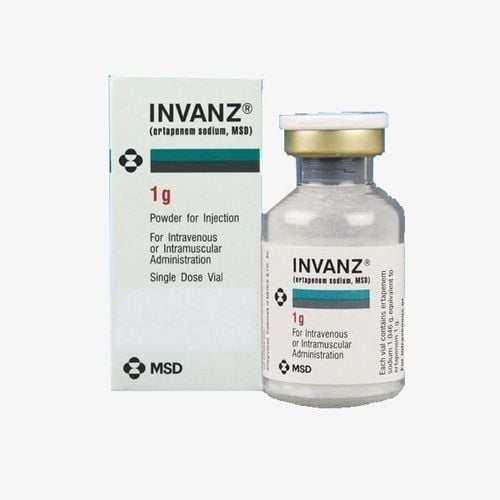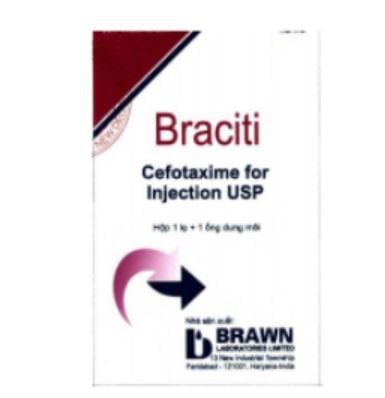This is an automatically translated article.
Farvinem drug contains the main active ingredient is Ertapenem, a beta-lactam antibiotic of the carbapenem group. Ertapenem has a bactericidal effect by binding to penicillin-binding proteins, thereby inhibiting bacterial cell wall synthesis.
1. What is Farvinem?
The Ertapenem ingredient in Farvinem has a bactericidal effect by binding to the penicillin-binding protein (PBP) on the outer membrane of bacteria, thereby inhibiting the synthesis of the bacterial cell wall. Ertapenem is stable to most beta-lactamases. Ertapenem is more stable than Imipenem under the action of dehydropeptidase enzyme present in renal tubules, so it does not need to be combined with cilastatin. The antibacterial spectrum of Ertapenem is narrower than that of Imipenem and has no effect on resistant strains of Acinetobacter and Pseudomonas aeruginosa.2. Uses of the drug Farvinem 1g
Farvinem medicine 1g is used to treat infections caused by susceptible strains including:
Respiratory tract infections Complicated intra-abdominal infections Complicated infections of the skin and subcutaneous tissue, including diabetic lower extremity infections. Complicated urinary tract infections, including pyelonephritis with or without complications. Acute pelvic infections, including postpartum endometritis, septic abortion, and post-tissue gynecological infections.
3. Dosage and usage of Farvinem
3.1. Intravenous administration: Add 10ml of distilled water for injection or 0.9% NaCl solution to the vial and shake well to dissolve completely. Then transfer the drug to an infusion bag containing 50 ml of 0.9% NaCl. Transfuse all of this fluid. The infusion time should last more than 30 minutes. Intramuscular: Add 3.2 ml of 1% or 2% lidocaine solution to the vial and shake well to dissolve completely. Immediately withdraw the reconstituted solution and inject deep intramuscularly into a large muscle. The drug should be used within 1 hour of reconstitution. 3.2. Dosage Dosage will vary according to the characteristics of each patient. The following is a reference dose of Farvinem in some cases:
Adults: The recommended dose of Ertapenem is 1g once daily. Children over 3 months to 12 years: The recommended dose of Ertapenem is 15 mg/kg twice daily, up to a maximum of 1 g/day. Hemodialysis patients: If 500 mg is given within 6 hours of dialysis, then 150 mg should be given after completion of dialysis. Patients with hepatic impairment: No dose adjustment of Ertapenem is required for patients with hepatic impairment. Patients with renal failure: Patients with glomerular filtration rate over 30ml/min, dose 1g/day. In patients with glomerular filtration rate less than 30ml/min, the recommended dose is 500mg/day.
4. What are the side effects of Farvinem?
Patients using Farvinem will experience some unwanted effects as follows:
Common: Headache, complications from injection / intravenous infusion such as phlebitis, thrombophlebitis, diarrhea, nausea , vomiting, rash, pruritus, increased AST, ALT, increased platelet count... Uncommon: Candida infection, pseudomembranous colitis, vaginitis, dizziness, drowsiness, constipation, acid reflux , dry mouth, dyspepsia, abdominal pain, weight loss, convulsions, bradycardia... Rare: Pneumonia, skin infection, surgical site infection, urinary tract infection, pelvic peritonitis, anxiety depression, arrhythmia, tachycardia, increased serum LDH, serum phosphate, decreased number of lymphocytes, monocytes...
5. Contraindications of the drug Farvinem
Farvinem is contraindicated in the following cases:
Patients with hypersensitivity to the active ingredient and other components of the drug. Patients taking drugs containing sodium valproate because this drug may reduce the concentration of sodium valproate in the blood plasma Do not administer intramuscularly to people sensitive to lidocaine and in patients with severe shock
6. What are the precautions when using Farvinem?
Central nervous system undesirable effects such as myoclonus, confusional state or convulsions may occur, which are common in patients with concomitant CNS disorders with decreased renal function. Anaphylaxis: Serious hypersensitivity reactions, including anaphylaxis have been reported. Anaphylaxis may also occur in patients with no prior history of allergic reactions to beta-lactams. Therefore, before taking Farvinem, it is necessary to carefully explore the patient's allergy history. As with other antibiotics, prolonged use of Ertapenem may lead to overgrowth of non-susceptible microorganisms. Use with caution in patients with renal failure, the elderly (decreased renal function). Dosage adjustment is required in patients with moderate to severe renal dysfunction because an increased risk of seizures has been reported in patients with decreased renal function. Farvinem may give false-positive results when determining urinary glucose by Benedict's reagent, Fehling's reagent or the Clinitest reaction. The drug can also give a positive result on the Coombs test. Since there are no reports of safety in pregnant women, the drug should be used during pregnancy only if the potential benefits outweigh the potential risks. Ertapenem is excreted in breast milk. Because of the risk of adverse effects in the child, Ertapenem should be avoided in nursing women.
7. Farvinem Drug Interactions
Drug interactions can lead to a variety of clinical consequences, including altering the effectiveness of treatment and/or increasing drug side effects. Therefore, patients need to inform medical staff of all drugs, dietary supplements, and vitamins that are being used. The following are some drug interactions of Farvinem that should be noted in clinical practice:
Probenecid competes with Ertapenem in tubular elimination. This reduces the clearance of Ertapenem and prolongs the half-life of Ertapenem. Ertapenem reduces serum valproic acid concentrations below the therapeutic range and may cause stroke. Therefore, the concomitant use of ertapenem with valproic is not recommended, and an alternative antibiotic should be considered. If concurrent use is mandatory, additional antiepileptic drugs should be considered. Above is the general information about the drug Farvinem. The information above is for reference only and cannot replace the guidance of a physician. Patients should consult a doctor or pharmacist before taking to ensure the safety and effectiveness of the drug.
Please dial HOTLINE for more information or register for an appointment HERE. Download MyVinmec app to make appointments faster and to manage your bookings easily.













